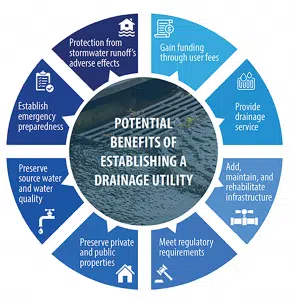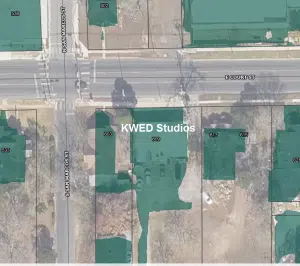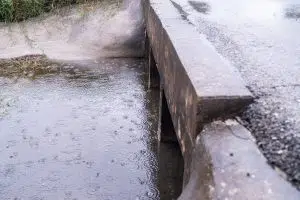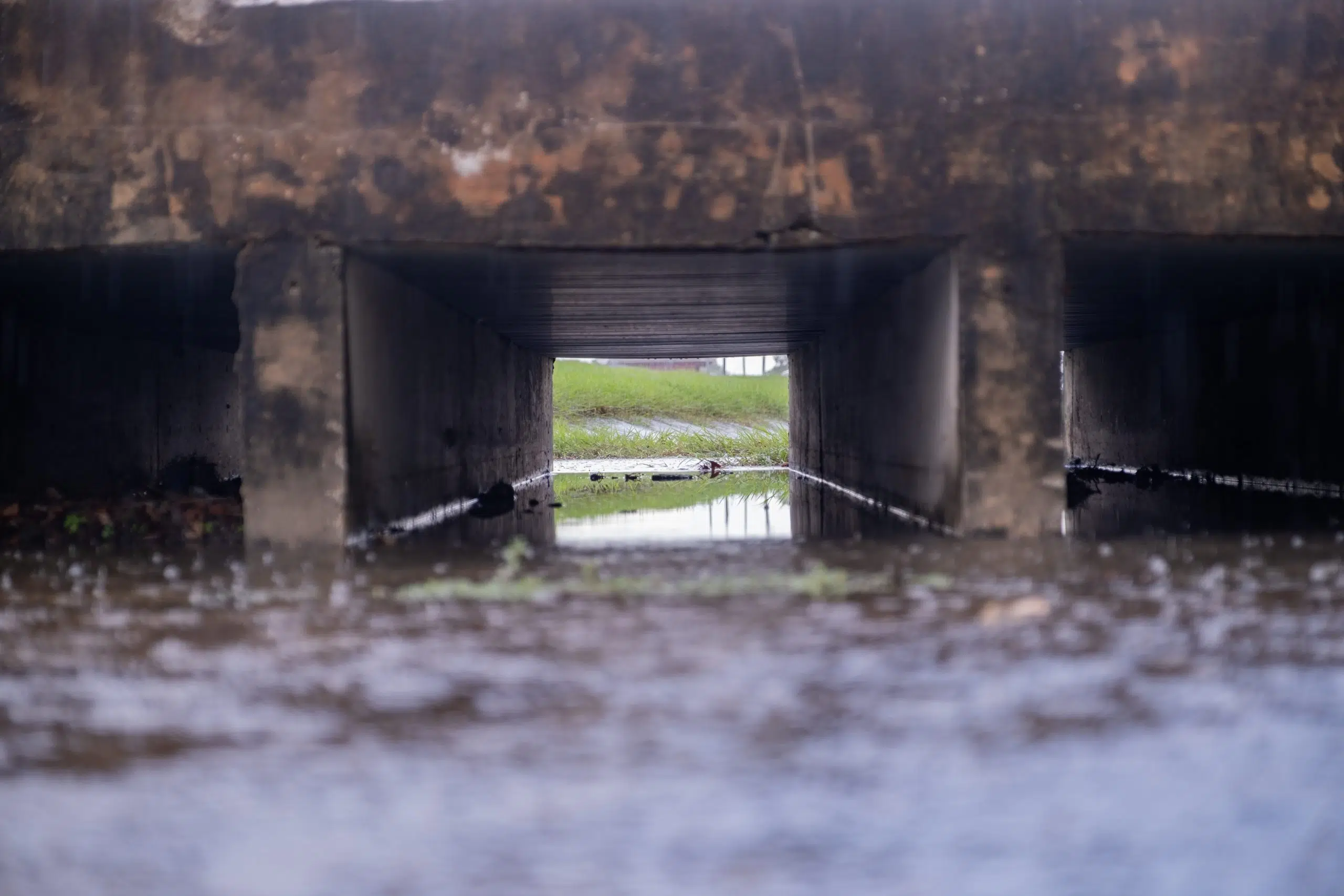 (Seguin) — The new year will bring with it a major change for how the city of Seguin goes about funding drainage projects. In January, the city will begin collecting a drainage utility fee from all properties within the city limits.The fee will allow the city to create a new storm water utility. Those projects have been funding primarily by property taxes in the past, but the new fee is expected to be a more equitable and better way to address some the drainage needs throughout the city.
(Seguin) — The new year will bring with it a major change for how the city of Seguin goes about funding drainage projects. In January, the city will begin collecting a drainage utility fee from all properties within the city limits.The fee will allow the city to create a new storm water utility. Those projects have been funding primarily by property taxes in the past, but the new fee is expected to be a more equitable and better way to address some the drainage needs throughout the city.
Mayor Donna Dodgen says this is something that’s been in the works for a long time.
“So before COVID, the city manager and the council decided to begin to pursue and look at this,” said Dodgen. “And then of course COVID came and we went into a holding pattern. And right after COVID…we started ramping back up. We started this process again. And it truly is a new utility.”
Most customers will be charged $3 per month, with most non-residential properities paying more based on the amount of impervious cover at each site. Mayor Dodgen says they’ve carefully studied this issue, and she believes it’s the best way to handle necessary improvements to the city’s drainage system.
“What we wanted to do was to provide a utility and provide a funding source — a sole supported funding source to help with our drainage. We have issues with drainage and infrastructure. We have issues with the drainage and what it does to our roads. So we wanted to help have enough money to do those sorts of things and to do the studies that (are needed). We need to see where we need to put our monies and (where to) put our emphasis, and then begin to do that. We wanted to plan and we wanted to be able to work that plan and have funding to answer that plan. So that’s what this is going to do. And when we initially talked about this, we looked at it (and) we we talked about a higher fee. We didn’t like that. So we settled on $3 a household unit…and we wanted to give it a year to phase in, because manufacturing (facilities) were going to be affected, schools were going to be affected, (and) other governmental entities were going to be affected. We wanted to talk about that and tell them, so that people could start budgeting for it. So that’s how it all started. Looking for out for our future and beginning to do exactly something for our drainage and for our streets,” said Dodgen.

This is a screenshot of the GIS tool that’s avaialble on the city’s website. It shows our KWED and Seguin Daily News offices. Based on the impervious cover calculations, the station would pay $9 per month for its storm water utility fee.
The fee was formally proposed in January of 2022, but Dodgen says they wanted to make sure that folks had nearly a full year to have their questions answered before the fee was collected — starting in 2023.
City Manager Steve Parker spent months helping to educate the community about the need for the fee and the new utility. Parker says city not only has some significant drainage problems in some areas, but he says those drainage issues are also creating some additional expensive problems when it comes to maintaining the city’s streets.
“We’re spending a lot of money on getting our roads up to a better condition. There was – and I’ll be honest — there were years and years where these roads were neglected. And this City Council over the last several years has made a dedicated effort to fix the roads, repair them. and get them up to the standard that everybody wants. But the problem is, is that if we have the same drainage system, then that water is just going to stand on those roadways. So instead of lasting 20 years 25 years, they’re going to last six to eight years. It does not matter how well we construct them, without getting that water off of there. And so this is a dedicated funding source that we can use to do those improvements to get that water off,” said Parker.
Parker says the city needs to begin investing more in its overall drainage system. He says if those improvements aren’t made, they’ll continue to see roads damaged unnecessarily.
“If you remember last year, we had a lot of rain over a several month period. I got more complaints about potholes and in that one to two-month period than I’ve ever gotten in my whole city management career. And that’s just because the water was not draining and it was, you know, it was just chipping away at the infrastructure. So when I explained it to citizens like that — they really do get it,” said Parker.
 Seguin is lagging behind some other cities when it comes to creating a storm water drainage utility and the fee that helps to fund it. Parker says the city has to be more deliberate about addressing these problems.
Seguin is lagging behind some other cities when it comes to creating a storm water drainage utility and the fee that helps to fund it. Parker says the city has to be more deliberate about addressing these problems.
“If you look at other communities, they have already taken the initiative to implement a drainage utility fee, where we can have a dedicated funding source to take care of these drainage issues as they arise. It’s going to allow us to do more mowing. It’s going to allow us to do more street sweeping. It’s going to allow us to do more projects related to all the things that we need to do to make us, you know, more sustainable,” said Parker. “That’s the message for the for the residents, the money that we’re spending on roads to repair them, will be wasted if we don’t find a way to get that water off of them at a quicker rate than they have now.”
The money generated by the fee will intially be used to help pinpoint an overall plan of attack. Parker says the city needs to determine what needs to be done, and which projects need to be prioritized based on any available funding.
“And we also will continue to develop the CIP plan, which is a capital improvements plan, because people will ask — when is my drainage going to be fixed? You know this will be also a tool as we go through and develop these projects that allow us to do a cost benefit analysis. If I have $500,000 to spend on a project and I can get 100 people out of the floodplain in one area, or I can get 2,000 people out of the floodplain and it still cost me $500,000. We’re going to…help 2000 people versus 100 people. So it may take some time to work through all these,” said Parker.
The city received some pushback on the fee from some residents, who suggested that the city continue to use property taxes to pay for these drainage improvements. Parker says it’s just not the best way to fund those projects. He says property taxes fund only a fraction of the city’s total operation. So the money just wouldn’t be there based on current ad valorem tax collections. He says they had to create a dedicated funding source that would not only help the city now, but in the future as well.
“This will be a fee that will go on in perpetuity. It’s not something we will just finish all our drainage projects, and (then) it (will) be done, and we’ll be able to remove it. You know, there’s always going to be needed maintenance. We’ve got to clear these. You know, if you drive through any of these places in town and you see these drainage culverts and how they get overgrown, how the creeks get overgrown — you know, these will be the ways that we’ll use that money to make sure that those drainageways are cleared and maintained the way they should be,” said Parker. “It’s a great tool and we’re very excited, but this is not something that’s new. Many, many cities…already have this fee and their fee is higher than ours is, but it is something that was probably very well needed. We always hate to recommend new fees, by any means. Whether it’s a tax or whether it’s a fee, it’s a thing I hate doing. But this is something that’s going to have a great benefit for our community. It may be a little uncomfortable at first, but it it’ll really pay off in the long run,”

Photo by Lizz Daniels
The city’s GIS (geographic information system) office has created an online interactive tool that will allow customers to look at their properties to determine exactly how much they will be charged. City Engineer Melissa Reynolds again stressed that residential customers will pay $3 per month. She says the GIS tool will help people see the proposed fees for other sites.
“For residential areas, when you click a residential parcel, you’ll see that regardless of what your impervious cover is, (and) your estimated fee is $3. When you click a commercial parcel or a non-residential parcel, you’ll see what their impervious cover is and then that is divided by the 2500 square foot, which was the equivalent residential unit (ERU), (and it) comes up with a new your your new ERU and that times $3 is what your fee is. And all of that calculation is laid out for you on the screen so you can see it. And we are going to implement appeals process as well. It will be web-based as well and that is for if we mess up. If we say it’s not residential and are showing something other than $3, yet the site is residential. There’s an appeals process for that. If you disagree with our assessment on what the impervious cover is of your site, we will have that option for you as well on how you can submit an appeal to that,” said Reynolds.
This is a large undertaking by the city, which is why officials say they have spent so much time on this in preparation for next month’s collection of the new fee. Reynolds says most folks will just see the new fee attached to their regular utility bill from the city of Seguin.
“If you get a standard city of Seguin water, sewer or trash bill, you will have a new line item. If you happen to be one of the few properties that does not have a utility bill yet, you will get one,” said Reynolds.
If you have questions about the stormwater utility fee, you can find a number of resources on the city’s website seguintexas.gov. You can also access the city’s GIS tool by visiting https://tinyurl.com/find-my-stormwater-rate.





